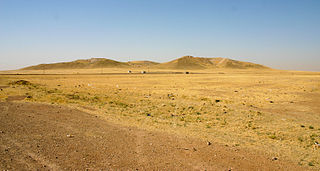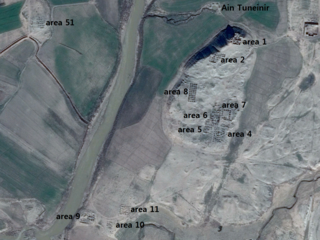Archaeological research
The site was excavated in 1988–1990 as part of the Western Hassake Dam Project, an international salvage project organized by the Syrian Directorate-General of Antiquities and Museums. The research was conducted under the auspices of the Polish Centre of Mediterranean Archaeology University of Warsaw and directed by Maria Krogulska (1988) and Piotr Bieliński (1989–1990). In the framework of the same project, the team also studied the site of Tell Djassa, located about 2.5 km away. [2]
Tell Abu Hafur consists of two tells: the main one is 200 m long and 16 m high, the other (Tell Abu Hafur East) 130 m long and 5 m high. [2] Nine archaeological layers were distinguished on the main tell. The youngest phase, dating to the Early Dynastic period, yielded the richest finds – the remains of four mud-brick houses located along a street paved with stones as well as seven graves. [1] The smaller tell functioned in later times, as attested by the remains of fortifications from the Mitanni period (2nd millennium BC) and structures dated to the Neo-Assyrian period. [3] Pottery finds indicate that the settlement continued in the Hellenistic, Parthian-Roman, and early Islamic periods. [1]
An interesting find was a terracotta figurine, a so-called eye idol, typical of the Uruk culture. Such idols have been found in different parts of the Near East: Mesopotamia, Syria, Elam, the largest number at Tell Brak. [4]

The Khabur River is the largest perennial tributary to the Euphrates in Syria. Although the Khabur originates in Turkey, the karstic springs around Ras al-Ayn are the river's main source of water. Several important wadis join the Khabur north of Al-Hasakah, together creating what is known as the Khabur Triangle, or Upper Khabur area. From north to south, annual rainfall in the Khabur basin decreases from over 400 mm to less than 200 mm, making the river a vital water source for agriculture throughout history. The Khabur joins the Euphrates near the town of Busayrah.

The Balikh River is a perennial river that originates in the spring of Ain al-Arous near Tell Abyad in the Eastern Mediterranean conifer-sclerophyllous-broadleaf forests ecoregion. It flows due south and joins the Euphrates at the modern city of Raqqa. The Balikh is the second largest tributary to the Euphrates in Syria, after the Khabur River. It is an important source of water and large sections have recently been subjected to canalization.

Tell Halaf is an archaeological site in the Al Hasakah governorate of northeastern Syria, a few kilometers from the city of Ra's al-'Ayn near the Turkish border. The site, which dates to the 6th millennium BCE, was the first to be excavated from a Neolithic culture, later called the Halaf culture, characterized by glazed pottery painted with geometric and animal designs.

Tell Brak was an ancient city in Syria; its remains constitute a tell located in the Upper Khabur region, near the modern village of Tell Brak, 50 kilometers north-east of Al-Hasaka city, Al-Hasakah Governorate. The city's original name is unknown. During the second half of the third millennium BC, the city was known as Nagar and later on, Nawar.
Hamoukar is a large archaeological site located in the Jazira region of northeastern Syria, near the Iraqi and Turkish borders. The early settlement dates back to the 5th millennium BCE, and it existed simultaneously with the Ubaid and the early Uruk cultures. It was a big centre of obsidian production. In the 3rd millennium, this was one of the largest cities of Northern Mesopotamia, and extended to 105 ha.
Tell es-Sweyhat is the name of a large archaeological site on the Euphrates River in northern Syria. It is located in Raqqa Governorate roughly 95 km northeast of Aleppo and 60 km south of Carchemish. Also, a Uruk site of Jebel Aruda and a Bronze Age site Tell Hadidi (Azu) are located just across the river.

Tell Arbid is an ancient Near East archaeological site in the Khabur River Basin region of Al-Hasakah Governorate, Syria. It is located 45 km south of Tell Mozan, the site of ancient Urkesh.
Peter M. Fischer is an Austrian-Swedish archaeologist. He is a specialist on Eastern Mediterranean and Near Eastern archaeology, and archaeometry. He belongs to the University of Gothenburg and is associated with the Austrian Academy of Sciences, Sweden. He is the founder and director of the Swedish Jordan Expedition, the Palestinian-Swedish Expedition at Tall al-Ajjul, Gaza. He became the director of the Swedish Cyprus Expedition in 2009 and carried out excavations at Hala Sultan Tekke since 2010. He is member/corresponding member of The Royal Society of Arts and Sciences in Gothenburg, Royal Swedish Academy of Letters, History and Antiquities. and The Austrian Academy of Sciences.

Tell Qaramel is a tell, or archaeological mound, located in the north of present-day Syria, 25 km north of Aleppo and about 65 km south of the Taurus mountains, adjacent to the river Quweiq that flows to Aleppo.

Tell Tuneinir is an archaeological site in northeastern Syria. It dates to the early third millennium BC and shows signs of continuous habitation lasting until the beginning of the 15th century AD with epochs during the early Byzantine Empire, when it was known as the city of Thannuris (Thannourios), and during the Ayyubid period.
Tell Kashashok is an archaeological site in the Khabur River Valley, of Northern Syria. The site is dated by pottery finds to the latter neolithic era, and early Dynastic era. The site was excavated by the Directorate General of Antiquities of Syria in 1987 and 1988. The Early Dynastic era includes a destruction layer, and an early adoption of cuneiform. It may have been known in antiquity as Kiš. A few clay numerical tablets from the EB III were found.
Bahra 1 is an archaeological site in the Subiya region on the coast of Kuwait Bay (Kuwait) associated with the Ubaid culture. It is one of the earliest Ubaid culture settlements in the Persian Gulf region, about 5500–4900 BC.
Subiya (Al-Subiyah) is a region in northern Kuwait on the north coast of Kuwait Bay (Kuwait), consisting of several micro-regions: Bahra, H3, Nahdain, Radha, Muhaita, Mughaira, Dubaij, and Ras al-Subiyah. The area features archaeological sites with tumuli graves, settlements, campsites, wells, and shell middens. Most of the tumuli date to the Early and Middle Bronze Age. Subiya is the location of the Silk City project, the project's first phase was launched in May 2019.
Tell Djassa is an archaeological site in Syria, in the Khabur River basin, in the area of the Khabur Triangle in Upper Mesopotamia.
Tell Saadiya is a tell, or archaeological settlement mound, in Diyala Governorate (Iraq).
Tell Rad Shaqrah is an archaeological site in Syria, in ancient Upper Mesopotamia. It is located on the northern bank of the Khabur River, about 15 kilometers from Hassake (Al-Hasaka).
Tell Raffaan is an archaeological site in Iraq, in ancient Upper Mesopotamia, in the valley of the Tigris River.
Tell Rijim is an archaeological site in Iraq, in ancient Upper Mesopotamia, in the valley of the Tigris River, about 25 kilometers to the north-west of Eski Mosul.
Piotr Bielinski is a Polish Mediterranean archaeologist, professor of humanities, specializing in the archaeology of the ancient Middle East. His research interests include the art - especially glyptics - and architecture of Mesopotamia, Syro-Palestine, Anatolia, and the Arabian Peninsula from the Chalcolithic to the Bronze Age. He has led over a dozen Polish archaeological expeditions to the Middle East.
Ginnig is a tell in Upper Mesopotamia that was occupied at the transition from the PPNB to the Pottery Neolithic.








